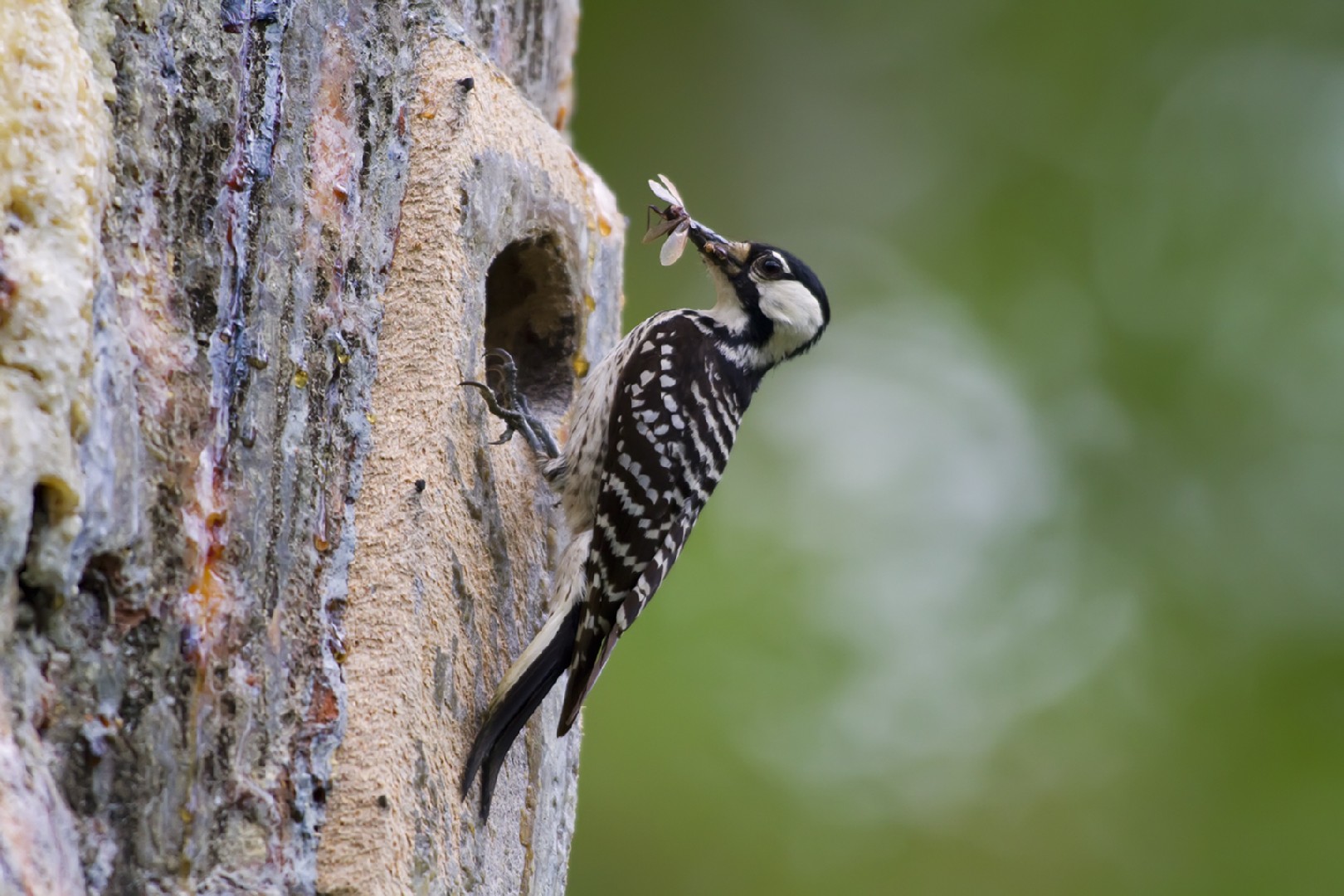Red-cockaded Woodpecker
A species of Three-toed woodpeckers Scientific name : Leuconotopicus borealis Genus : Three-toed woodpeckers
Red-cockaded Woodpecker, A species of Three-toed woodpeckers
Botanical name: Leuconotopicus borealis
Genus: Three-toed woodpeckers
Content
Description People often ask General Info
 Photo By U.S. Fish and Wildlife Service Southeast Region , used under CC-BY-2.0 /Cropped and compressed from original
Photo By U.S. Fish and Wildlife Service Southeast Region , used under CC-BY-2.0 /Cropped and compressed from original Description
This small woodpecker was once abundant in USA, but now the red-cockaded Woodpecker is rare and considered endangered. This highly territorial species is found in old pine forests, where it forages trunks and branches in search of insects. The red-cockaded Woodpecker is a bird with complex social life. It lives in isolated groups, which usually consist of a mating pair, their current-year nestlings, and several so-called "helpers".
Size
18 - 23 cm
Life Expectancy
16.1 years
Nest Placement
Cavity
Feeding Habits
Red-cockaded Woodpecker predominantly consumes insects such as ants, termites, beetles, and arthropods found under pine tree bark, including corn earworms at times. While they mostly eat insects, a smaller part of their diet includes seeds and fruits like pine seeds, berries, and grapes. Red-cockaded Woodpecker shows sexual dimorphism in foraging, with males frequently feeding on upper parts of pine trees, and females on the lower trunk. About 90% of their foraging occurs on pine trees, favoring larger ones for the abundant prey under the looser bark. They occasionally forage in mixed-species flocks, particularly in winter.
Habitat
Red-cockaded Woodpecker inhabits fire-regulated pine savannas of the southeastern United States, favoring longleaf pines and other southern pine species. They require habitats with an open understory for nesting in living pines, environments which form through regular natural fires. Their presence extends to mature loblolly, slash, and shortleaf pine forests, with some populations in pine-cypress wetlands.
Nest Behavior
Red-cockaded Woodpecker nests in cavities excavated by breeding males, usually the most recent among several. Nest building coincides with cavity excavation, and they display resin use as a defense. Red-cockaded Woodpecker shows bi-parental care but specifics on egg-laying patterns aren't provided.
Nest Characteristics
Red-cockaded Woodpecker's nest is located in live pine trees affected by red heart fungus, often over 100 feet high, with a south or west-facing entrance measuring 2–3 inches. The cavity interior is 3-4 inches wide, lined with wood chips.
Dite type
Insectivorous
People often ask
General Info
Feeding Habits
Bird food type
Behavior
Red-cockaded Woodpecker exhibit a range of specialized behaviors, particularly in their nesting and foraging habits. They carve out cavities in living pines, creating sap wells that ward off predators. These birds are highly social, living in cooperative family groups where nonbreeding adults assist with chick rearing and territory defense. While males tend to remain in their natal territory, females usually disperse. Monogamous breeding pairs often remain together for life. Red-cockaded Woodpecker forage in pine trees, leveraging their tails for stability as they search for food, and drink from natural reservoirs on trees. Their home range varies but can be extensive, with individual sleeping quarters within the communal territory. They demonstrate high fidelity to their nesting sites, reusing cavities for years.
Distribution Area
Historically, this woodpecker's range extended in the southeastern United States from Florida to New Jersey and Maryland, as far west as eastern Texas and Oklahoma, and inland to Missouri, Kentucky, and Tennessee. Today it is estimated that there are about 5,000 groups of red-cockaded woodpeckers, or 12,500 birds, from Florida to Virginia and west to southeast Oklahoma and eastern Texas, representing about 1% of the woodpecker's original population. 
Species Status
The red-cockaded woodpecker suffers from habitat fragmentation when habitable pines are removed. When a larger cluster of birds gets split up, it is difficult for the young to find mates and eventually becomes an issue regarding species dispersal. While dispersing in search of new places to settle, the red-cockaded woodpecker encounters habitats of competing woodpecker species. The red-cockaded woodpecker has been the focus of conservation efforts even before the passing of the Endangered Species Act in 1973. 

 Photo By U.S. Fish and Wildlife Service Southeast Region , used under CC-BY-2.0 /Cropped and compressed from original
Photo By U.S. Fish and Wildlife Service Southeast Region , used under CC-BY-2.0 /Cropped and compressed from original Scientific Classification
Phylum
Chordates Class
Birds Family
Woodpeckers Genus
Three-toed woodpeckers Species
Red-cockaded Woodpecker